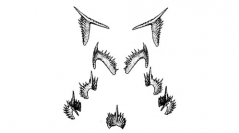

 Comptes Rendus Palevol
10 (2-3) - Pages 107-115
Comptes Rendus Palevol
10 (2-3) - Pages 107-115Conodonts are an extinct group of organisms, known from the Upper Cambrian to the Triassic. They have no extant representatives, and tooth-like buccal elements are usually the only remains of the animal found in the sediments. Therefore, most of their taxonomy rests on these elements that are good stratigraphic tools for these ancient periods, due to their rapid morphological evolution. Conodont species are usually described species that are based on either clusters of elements corresponding to an entire apparatus (natural assemblages), or on the most frequently preserved element. These described species are acceptable stratigraphic tools, but hardly consider the dimension of the variation that a biological species can encompass through time and space. In order to tackle temporal, environmental and biogeographical changes, recent studies have shown that morphological variation should be taken into account by quantitative analyses, aiming at getting at the closest of what the former species might have been.
Extinct species, Conodonts, Paleozoic, Evolution, Morphometrics